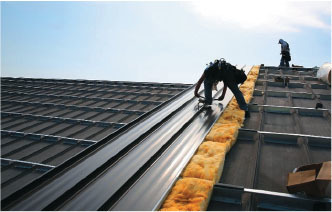
Retrofitting older metal building roofs continues to grow in popularity, but there are many questions about what can and cannot be done over an old metal roof. The following are questions that commonly come up about retrofitting an existing metal roofed building.
1. Can you only retrofit 12-inch, on-center screw down, R-panel type roofs?
No. Metal panels of all types and rib spacings can be retrofitted – screw-down, standing seam and corrugated.
2. If you have an existing screw down roof, do you have to put back another screw-down roof?
No, you can upgrade to a new standing seam roof that has few, if any, exposed fasteners by using the proper retrofit framing system. You can install a new screw-down roof, but remember screw-down roofs have approximately 0.8 fasteners per square foot, thus a 10,000 sf building will have at least 8,000 fastener penetrations, a common source of leaks. Standing seam roofing is also the perfect platform for attaching photovoltaic (PV) panels. The PV panels can be attached to the standing seam roof without penetrating the roof and, most importantly, this new metal roof will have a 40-60 year life.

3. Can I remove a screwdown roof and install a new standing seam roof?
This is possible but could end up being a very expensive option. Removing the old roof will also remove the diaphragm strength the old roof provides. This can make the entire building structurally unstable without significant re-bracing of the existing purlin system. Retrofitting can enhance the diaphragm strength and is the perfect platform for the new standing seam metal roof.
4. My roof has been coated or had foam spray applied to it. Can it be retrofitted?
Absolutely. Coatings are almost never a problem unless the coating has trapped moisture between the panel and the coating, causing severe corrosion of the existing panels and purlins. Foam coating is a bit more difficult, but the entire roof does not have to be scrapped clean, only a 2-inch wide strip directly above the purlin lines. The retrofit framing will be designed to be taller than the depth of the foam so it doesn’t interfere with the new roof.
5. For condensation, is insulation or ventilation needed under the new roof?
Most design professionals will advise to always ventilate a cavity unless it is completely filled with insulation. Retrofitting is the perfect time to increase the R-values of the roof system. I would suggest filling the cavity with raw, un-faced fiberglass insulation. It’s easy to do and fairly inexpensive. Rigid insulation systems are also easily done. You can choose not to insulate but you must ventilate the cavity. Keep in mind if you don’t insulate or install foam blocking and the new roof is standing seam, you may experience something called “panel rumble.” This is when, in certain wind conditions, the pan section of a standing seam panel will flutter and hit the subframing below making a rumbling noise.
6. Coating is just as good and less expensive too, right?
Well, it will be less expensive, but did you know coatings are not waterproof? They are commonly sold that way, but coatings are only intended to extend the life of the existing roof surface they are covering.
When it is time to reroof that old metal roof, look seriously at they many options available for retrofitting your roof. Don’t spend a significant amount of money for a 2-10 year patch that will have annual maintenance and repairs, when you can have a 40-60 year life roof that is code compliant, highly insulated and available with weathertightness warranties.
 AAPA Seaports
AAPA Seaports


